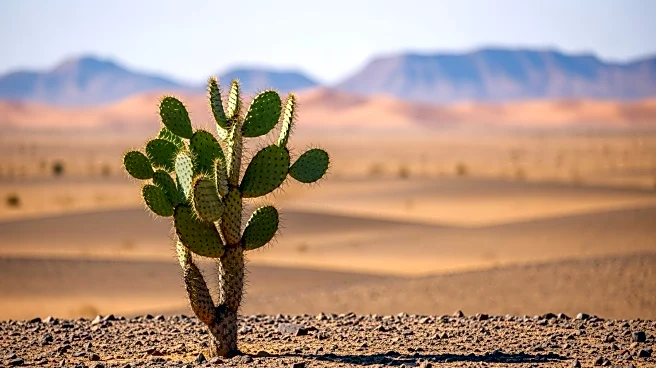What's Happening?
A study has modeled the invasive potential of the opuntia cactus, commonly known as the prickly pear, in Saudi Arabia's arid ecosystems. Using the Maxent ecological niche model, researchers assessed current
and future distribution trends, revealing high predictive accuracy for suitable habitats. Key environmental variables influencing the cactus's distribution include maximum temperature, vegetation index, precipitation, and soil organic carbon. The model predicts the cactus's current distribution is concentrated in western and southwestern Saudi Arabia, particularly in regions with moderate elevation and favorable climatic conditions.
Why It's Important?
The invasive spread of the opuntia cactus poses ecological challenges, potentially disrupting native ecosystems and agricultural practices. Understanding its distribution helps in managing its impact on biodiversity and land use. The cactus's ability to thrive in arid conditions could lead to competition with native species, affecting forage availability and traditional pastoral systems. The study's insights into environmental determinants can guide conservation efforts and inform land management policies to mitigate the cactus's invasive effects.
What's Next?
Future climate change scenarios suggest shifts in the cactus's distribution, with potential expansions into new regions. Under moderate and high emissions scenarios, the cactus may spread northward and inland, adapting to changing temperature and precipitation patterns. This could necessitate proactive management strategies to prevent further ecological disruption. Monitoring and controlling the cactus's spread will be crucial in preserving native biodiversity and maintaining ecosystem balance.
Beyond the Headlines
The study highlights the broader implications of climate change on invasive species dynamics. It underscores the importance of integrating ecological modeling in environmental policy-making to anticipate and address invasive threats. The cactus's spread could serve as a case study for understanding the interplay between climate change and biological invasions, informing global conservation strategies. Ethical considerations arise in balancing agricultural development with ecological preservation, emphasizing the need for sustainable land use practices.













